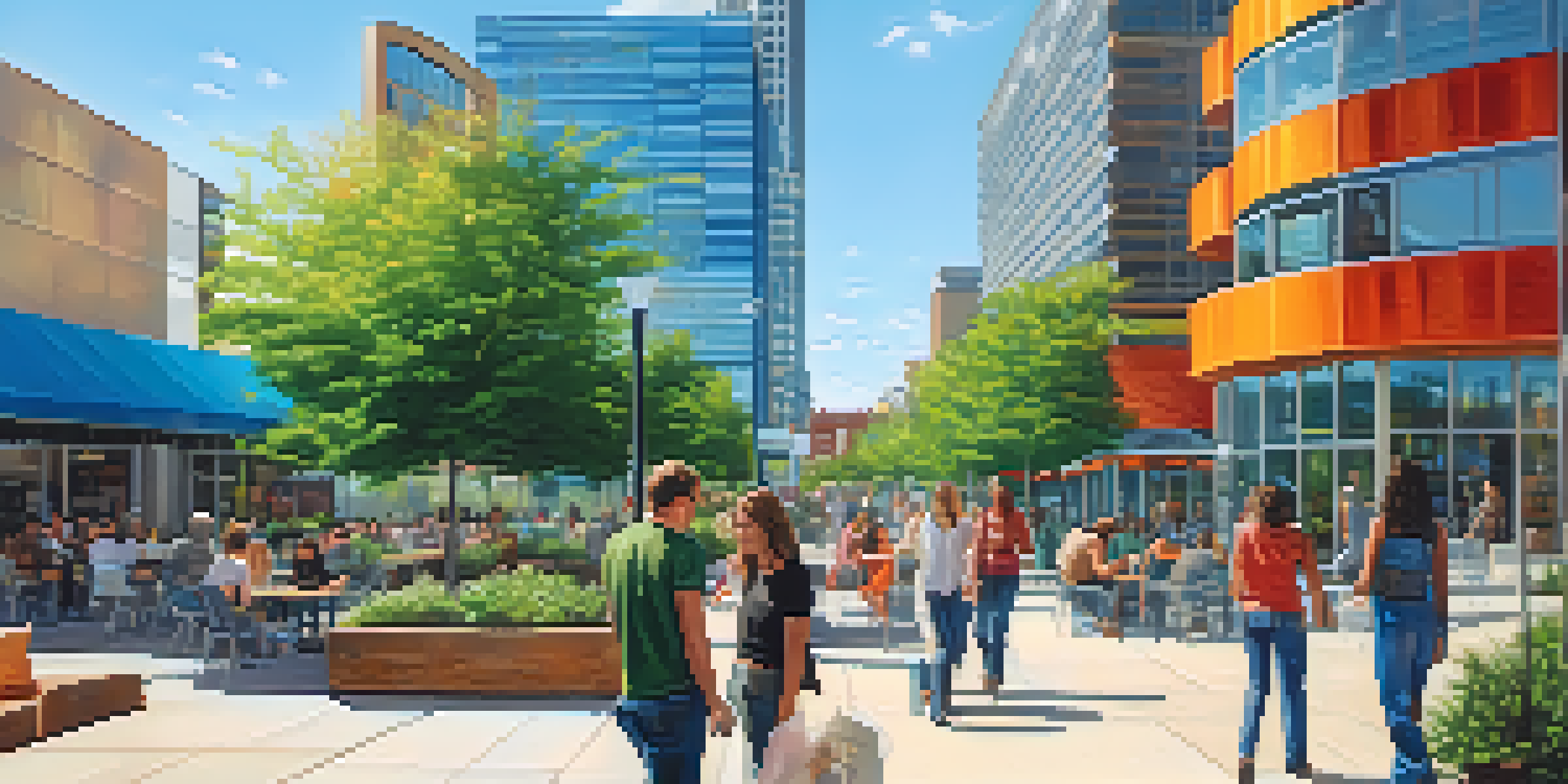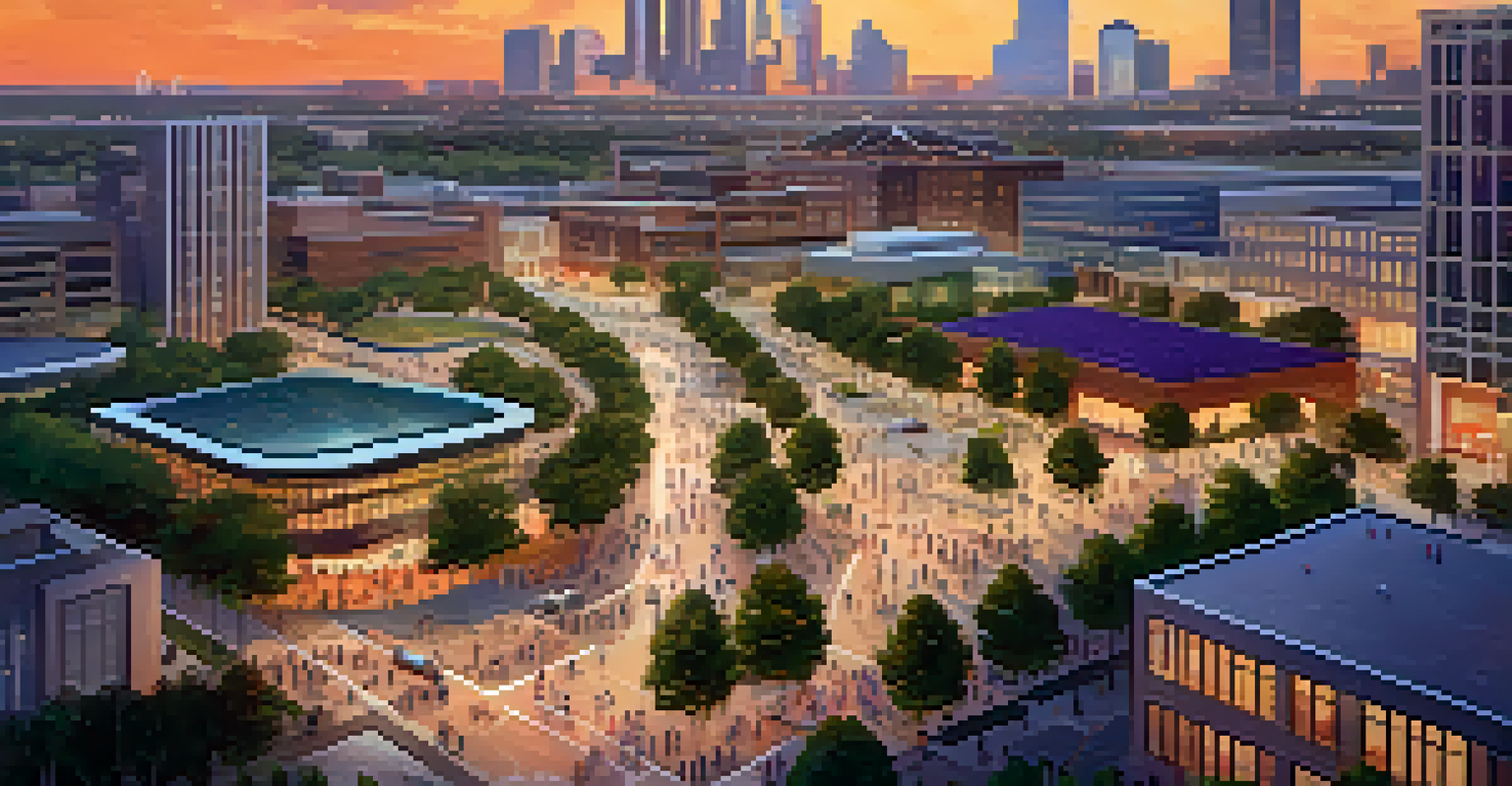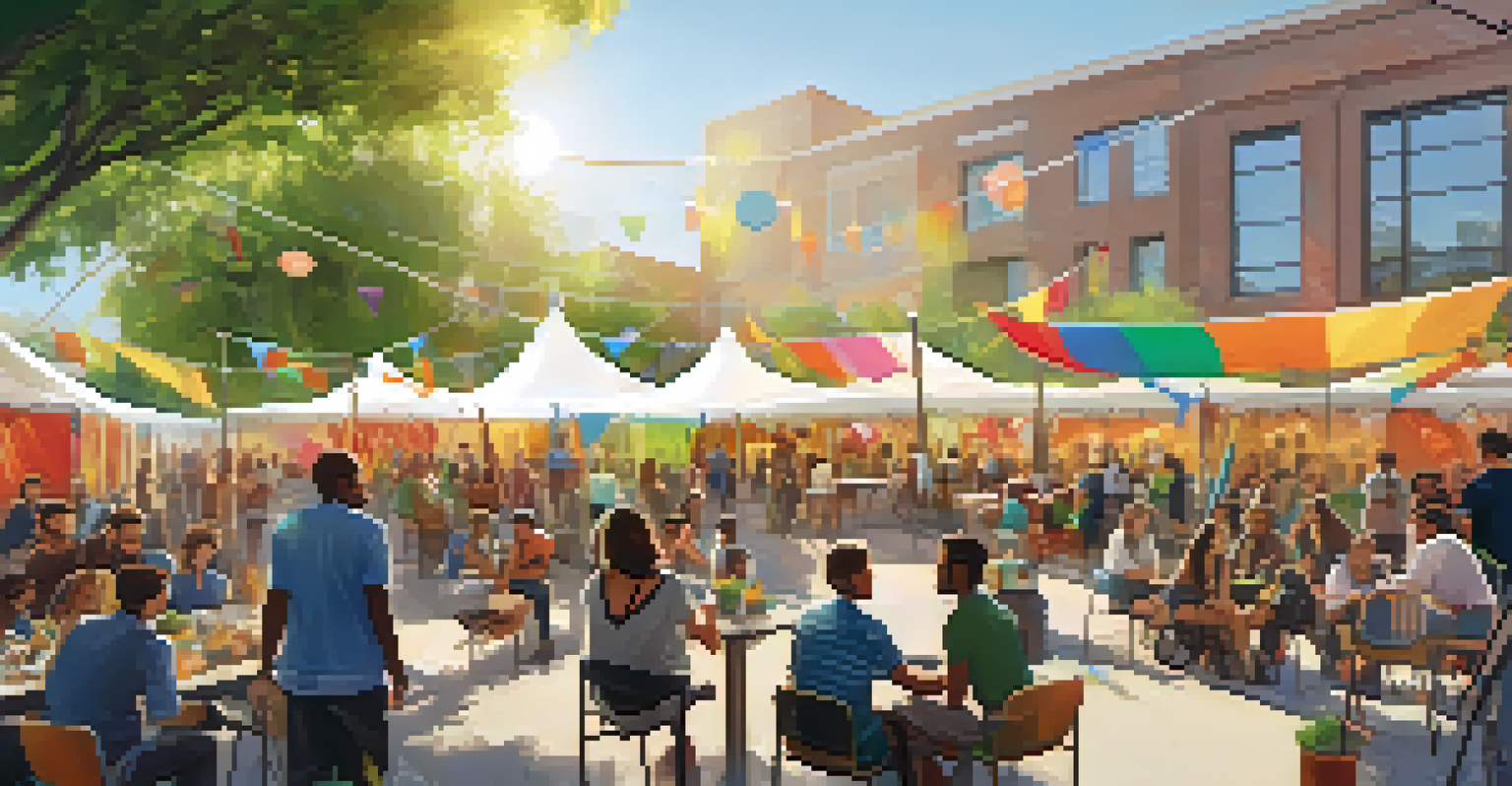The Impact of Innovation Districts on Dallas's Economy

Understanding Innovation Districts and Their Role
Innovation districts are urban areas designed to foster collaboration among businesses, startups, and research institutions. They create a vibrant ecosystem that encourages creativity and the sharing of ideas, much like a bustling marketplace where everyone benefits from each other's presence. In Dallas, these districts have become hotbeds for innovation, attracting talent and investment.
Innovation distinguishes between a leader and a follower.
The concept is not just about physical space; it’s about creating a culture that nurtures innovation. Picture a neighborhood where tech companies, universities, and small businesses coexist and thrive together. This collaborative environment leads to increased productivity and new job opportunities, making the city an attractive destination for young professionals and entrepreneurs.
As more people flock to these innovation hubs, the local economy experiences a ripple effect. Increased foot traffic boosts local businesses, while higher demand for housing drives construction and real estate development. Overall, innovation districts play a crucial role in shaping the economic landscape of Dallas, making it competitive on a national level.
Economic Growth Driven by Innovation Districts
Innovation districts contribute significantly to the economic growth of Dallas. They attract startups and established companies alike, creating a diverse economic base that can withstand market fluctuations. For example, the presence of tech giants often leads to an influx of smaller tech firms seeking to benefit from the established ecosystem, fostering a spirit of entrepreneurship.

Additionally, these districts often lead to job creation in various sectors, from technology to service industries. As new businesses emerge and existing ones expand, thousands of jobs are generated, supporting the local workforce. This job growth is critical for Dallas, especially as it competes with other major cities for talent and investment.
Innovation Districts Drive Growth
Innovation districts in Dallas attract businesses and talent, fostering a diverse economic base that supports job creation.
Moreover, innovation districts can enhance the city’s tax base, providing more resources for public services and infrastructure. The additional revenue can be reinvested into community projects, schools, and transit systems, further improving the quality of life for residents. In essence, the economic impact of these districts is multifaceted, benefiting both businesses and the community.
Enhancing Quality of Life Through Innovation
The presence of innovation districts not only fuels economic growth but also enhances the overall quality of life for Dallas residents. By creating vibrant, walkable communities filled with amenities, they encourage a lifestyle that values connectivity and collaboration. Think of it as a neighborhood where you can grab a coffee, attend a workshop, and meet like-minded individuals—all within a short stroll.
The best way to predict the future is to create it.
These districts often prioritize green spaces, public art, and community events, making them appealing places to live and work. This focus on livability attracts a diverse demographic, including families, young professionals, and retirees, all seeking a dynamic environment. As a result, innovation districts become integral parts of the city’s identity, fostering a sense of belonging and community pride.
Furthermore, as innovation districts evolve, they often invest in educational and cultural programs, providing opportunities for lifelong learning. Workshops, talks, and events that promote creativity and innovation not only benefit individuals but also strengthen the community. The synergy created by these initiatives enriches the cultural fabric of Dallas, making it a more vibrant place to live.
Attracting Investment and Talent to Dallas
One of the most significant impacts of innovation districts is their ability to attract investment and talent to Dallas. Investors are drawn to the potential for high returns in areas buzzing with innovation and entrepreneurship. As these districts gain recognition, they become magnets for venture capitalists and angel investors looking to support the next big idea.
Talent, especially in tech and creative industries, is also attracted to these thriving environments. Professionals are often seeking more than just a job; they want to be part of a movement. Innovation districts offer a sense of purpose and belonging, where individuals can collaborate on groundbreaking projects and be part of something larger than themselves.
Enhancing Community Quality of Life
These districts contribute to a vibrant lifestyle by prioritizing walkable communities and fostering a sense of belonging.
This influx of investment and talent fosters a cycle of growth, where established companies benefit from the creativity and energy of startups, and vice versa. As Dallas continues to position itself as a hub for innovation, the city stands to gain immensely from this dynamic exchange, further solidifying its status in the national and global economy.
Challenges Facing Innovation Districts in Dallas
While innovation districts offer numerous benefits, they also face challenges that can hinder their growth and impact. One major issue is the potential for gentrification, where rising property values and rents displace long-term residents and local businesses. This shift can create a divide between newcomers and established community members, undermining the original intent of fostering collaboration and inclusivity.
Another challenge is ensuring that the districts remain accessible to all socioeconomic groups. If innovation districts cater solely to high-income professionals, they risk becoming exclusive enclaves that do not reflect the diversity of Dallas. Community engagement and involvement in the planning process are essential to create spaces that benefit everyone.
Additionally, the rapid pace of technological change can make it difficult for innovation districts to stay relevant. Continuous evolution is necessary to meet the demands of businesses and residents alike. By addressing these challenges head-on, Dallas can ensure that its innovation districts thrive and remain a source of pride for the community.
The Role of Government in Supporting Innovation Districts
Government support plays a crucial role in the success of innovation districts. Local policymakers can create an environment conducive to growth by implementing favorable zoning laws, providing tax incentives, and investing in infrastructure. Such support can attract businesses and encourage startups to take root, creating a robust ecosystem.
Moreover, collaboration between government, private sectors, and local communities is essential. By fostering partnerships, stakeholders can work together to address challenges and leverage resources effectively. This collaborative approach ensures that the development of innovation districts aligns with the community’s needs and aspirations.
Government Support is Essential
Local government plays a critical role in the success of innovation districts by implementing supportive policies and fostering community collaboration.
Additionally, public funding for educational initiatives and workforce development programs can enhance the talent pool within these districts. By investing in education and training, the government can ensure that residents are equipped with the skills needed to thrive in an evolving job market. In this way, government involvement is a key ingredient in the recipe for successful innovation districts.
Future Prospects for Dallas's Innovation Districts
The future of innovation districts in Dallas looks promising, with ongoing developments and initiatives aimed at fostering growth. As the city continues to embrace technology and innovation, these districts will likely evolve into even more dynamic spaces. New projects and collaborations are constantly emerging, reflecting the city’s commitment to remaining at the forefront of economic development.
Future trends may include a greater emphasis on sustainability and social equity within these districts. As communities demand environmentally friendly practices and inclusivity, innovation districts that prioritize these values will stand out. This shift can lead to innovative solutions that benefit both the economy and the community, creating a win-win scenario.

Ultimately, the success of Dallas's innovation districts will depend on the collective efforts of businesses, residents, and policymakers. By working together, they can harness the power of innovation to create a thriving economy that benefits everyone. As these districts continue to flourish, they will play a pivotal role in shaping the future of Dallas.